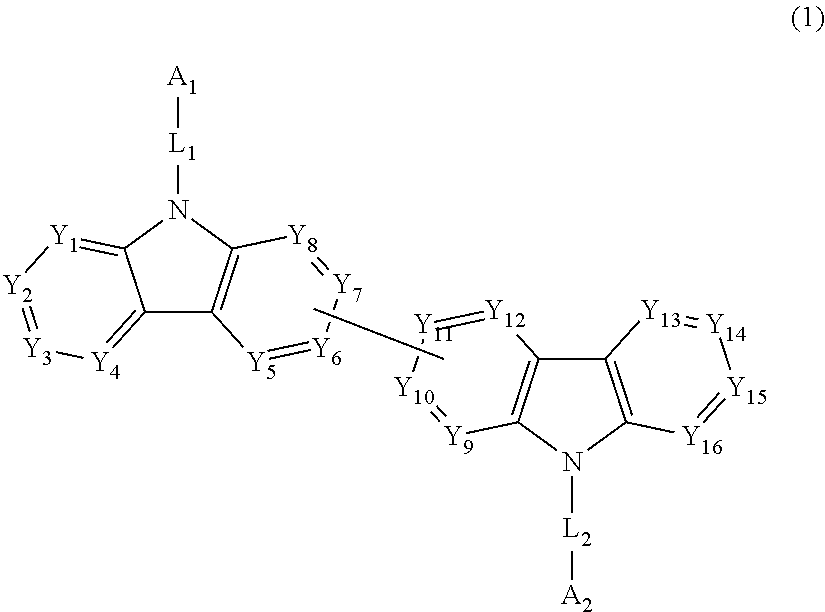Biscarbazole derivative and organic electroluminescent element using same
a technology of organic electroluminescent elements and biscarbazole, which is applied in the direction of luminescent compositions, organic chemistry, chemistry apparatuses and processes, etc., can solve the problems of shortening the lifetime of phosphorescent organic el devices as compared, compound to be used in light emitting layers must have a large energy gap, and achieve high emission efficiency and long lifetime
- Summary
- Abstract
- Description
- Claims
- Application Information
AI Technical Summary
Benefits of technology
Problems solved by technology
Method used
Image
Examples
synthesis example 1-1 (
Synthesis of Compound 1-1)
[0237]
[0238]In an argon atmosphere, 3-bromofluoranthene (2.3 g, 8.1 mmol), Intermediate 1-1 (3 g, 7.3 mmol), Pd2(dba)3 (0.14 g, 0.15 mmol), P(tBu)3HBF4 (0.17 g, 0.6 mmol), sodium t-butoxide (1.1 g, 11 mmol), and dry xylene (30 mL) were charged in a three-necked flask in this order, and the resultant mixture was refluxed under heating for 8 h.
[0239]The solid generated by adding water to the reaction liquid was successively washed with hexane and methanol and then purified by silica gel column chromatography, to obtain Compound 1-1 (2.9 g, yield: 65%).
[0240]FD-MS analysis: m / e=608 for molecular weight of 608.
synthesis example 1-2 (
Synthesis of Compound 1-2)
[0241]
[0242]The procedure of Synthesis Example 1-1 was repeated except for using Intermediate 1-2 (2.5 g, 8.1 mmol) in place of 3-bromofluoranthene and toluene (30 mL) in place of xylene, to obtain Compound 1-2 (3.3 g, yield: 71%).
[0243]FD-MS analysis: m / e=634 for molecular weight of 634.
synthesis example 1-3 (
Synthesis of Compound 1-3)
[0244]
[0245]The procedure of Synthesis Example 1-2 was repeated except for using Intermediate 1-3 (2.5 g, 8.1 mmol) in place of Intermediate 1-2, to obtain Compound 1-3 (3.7 g, yield: 80%).
[0246]FD-MS analysis: m / e=634 for molecular weight of 634.
PUM
| Property | Measurement | Unit |
|---|---|---|
| internal quantum efficiency | aaaaa | aaaaa |
| internal quantum efficiency | aaaaa | aaaaa |
| work function | aaaaa | aaaaa |
Abstract
Description
Claims
Application Information
 Login to View More
Login to View More - R&D Engineer
- R&D Manager
- IP Professional
- Industry Leading Data Capabilities
- Powerful AI technology
- Patent DNA Extraction
Browse by: Latest US Patents, China's latest patents, Technical Efficacy Thesaurus, Application Domain, Technology Topic, Popular Technical Reports.
© 2024 PatSnap. All rights reserved.Legal|Privacy policy|Modern Slavery Act Transparency Statement|Sitemap|About US| Contact US: help@patsnap.com










